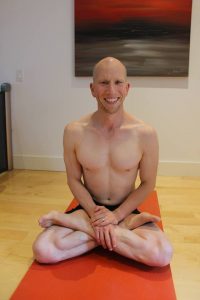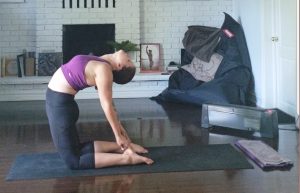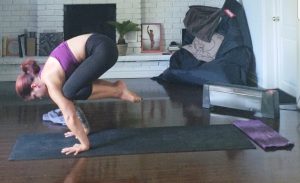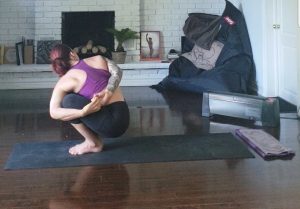sa tu dirghakala nairantarya satkarasevito drdhabhumih:
Practice that is done for a long time, without break and with sincere devotion becomes a firmly rooted, stable, and solid foundation.
Yoga Sutras 1.14
For the last few weeks, I’ve been staying at my moms outside of the city, which means I’ve had to resort to the ever-challenge home practice.
I have to admit, it’s been really hard to get on my mat. I mean yes, I have a 9-month old and the 7th series struggle is very real, but when I’m at home and the Shala is within reach, I never seem to have a problem getting to practice. I’m always motivated to get up, get out and do my practice. But while I’m here, it’s been struggle city.
It’s in these moments I realize how lucky I am to have a community, a shala, and an amazing teacher to motivate me to get on my mat.
To those who aren’t as lucky as me; to those who have to get up every day and motivate themselves to practice, I salute you!
The reality is, not everyone has the luxury of being in a Shala, amidst energy and teachers for every practice.
So this week I sought the help of some amazing practitioners who are killing it with their home practice for some suggestions. Here is some advice from the best!
Meet Jeff Goodman.

Ashtanga Practitioner. Yoga Teacher. Husband. And Daddy extraordinaire to 2 tiny humans.
What feels like 100 years ago (but in reality is 3), I would wake up and walk the 16 minutes from my old condo to AYCT. Maintaining a 6 day a week practice at the studio took a lot of commitment but it was possible and sustainable. I was able to do it while working long hours full time and teaching classes on the side. Moving further away made it harder, but I was still able to get to the studio a few times a week and would practice at home on the days when I couldn’t make it. Life was pretty simple back then.
Then this happened:

These days, distance from the studio on top of balancing an incredibly precocious 2- year-old with another baby on the way has definitely changed how I approach my practice, along with pretty much every other aspect of my life!
What motivates you to practice every day?
I always feel better after practice than before practice. Knowing this is a huge part of how I stay motivated to get on my mat whenever (and wherever) I can. In addition to that, I’ve been at this long enough to know that I am genuinely happier, calmer and more patient when I’m able to practice regularly. Knowing that the non-physical benefits of this practice can make me a better husband/father/employee/human is a powerful motivator. Also, I get really grumpy when I can’t practice (just ask my incredibly supportive wife about that! ?) .
On days where it’s particularly tough, I find that breaking the practice down into pieces can be very helpful. “I’ll just do some Sun As and see how I feel.” can very often evolve to include Sun Bs, standing, primary etc. I usually find once I start practicing and get over that initial struggle to get on my mat the rest of my practice doesn’t feel so daunting anymore.
While it may seem a bit counter-intuitive, I’ve also discovered that being crunched for time can also be a motivating factor. Knowing that if I don’t get a practice in I most likely won’t have another chance that day can sometimes be enough to get me on my mat.

What do you do when you get to a pose that you need help with, but there’s no one there to help? How do you deal with that physically and mentally?
Being away from the studio obviously means being away from instruction and adjustments. There are a few poses that I’ve been forced to seriously reconsider since shifting to a home practice. Kapotasana has always been an epic challenge for me. I’ve never been able to catch my heels without a gargantuan assist that involves a teacher standing on my calves and a fair amount of prayer. These days I give myself three attempts, with the third one being the deepest before I move on. This was much more difficult when I was first getting used to my new relationship to the practice but is almost liberating to me now. I use the same approach with any pose I am stuck on or struggling with (tips on Vasishthasana anyone?!) .
Here are my tips for a sustainable home practice:
- Don’t be so hard on yourself! Especially if you miss or must shorten your practice. Guilt and resentment don’t help. I need to take this advice more often.
- Practice when and where you can. I found a spot I can use at work over my lunch hour. Gone are the days of practicing at the exact same time every day.
- Find a good space, limit distractions (no screens around, keep your phone in another room etc.).
- Having a supportive partner is a such a benefit.
- Be less rigid about your practice.
- Don’t measure ‘progress’ by what pose you are on or how quickly you accumulate poses.
Now meet Kat Hache.

Ashtanga practitioner. Handstand queen. Sales extraordinaire.
Here’s what she had to say:
Committing to doing anything 6 days a week, for most of us means sometimes you’re going to have to go it alone. I’m not always able to make it into the shala due to work obligations, travel, etc, so I’ve had to become consistent with a partial home practice.
I love the quote from Jocko Willink that says, “Discipline = Freedom”. This is something I tell myself almost every day to keep me on track with my practice and my life.
It means, by having discipline, and doing the hard stuff when you’re supposed to, regardless of your feelings at that moment, you slowly lay the foundation for achieving your goals.
Brick by brick
Day by day
Starting small with your daily lifestyle and habits, consistently with discipline, eventually, you build good habits, you build a strong mind and a healthy lifestyle. By building these positive traits in your life, you have freedom.

Below are the 3 main tools I use to help me stay disciplined with a 6 day a week practice.
Create a routine
Whether I’m practicing at the shala or practicing at home/away, I have the same routine. This is both a physical and mental preparation and makes it easier to get on my mat when I go through these same steps each time. First things first, coffee – or some form of caffeine. If I’m travelling, sometimes I’ll have Vega sugar free pre work out because it’s easy to just add water.
Next, If I’m at home, I’ll lay out my mat and turn on my heater. When I’m not at home, and there’s no heater, I’ll wear layers until I warm up.
Then I’ll take a hot shower to wake me up a bit and allow it to warm up my muscles.
Lastly, I’ll light a candle or incense to remind me that although physically alone, we’re all in this together.

Consistency
The reality is that if you want to practice at home or even 6 days a week at the shala, you need to be consistent. It eventually becomes part of your daily life, and you just feel better whenever you practice. The above routine keeps me consistent, and it’s helped me to remain adaptable. Adaptable in that I don’t allow myself to create excuses for not practicing.
Keeping to that routine, I’ve stayed consistent even in hotel rooms that are all carpet because I’ve done what I can in a tiny tiled bathroom. I’ve had layovers when traveling, so I’ve practiced in corners of airports, been in dorms of hostels, so I’ve practiced outside on a balcony with layers on.
These weren’t the ‘best’ practices. But practicing through adverse situations, when you could very easily make excuses, deep seeds this routine.
The more you make it a priority, the easier it becomes to stick to.

Accountability
Put your phone in a cup and videotape your practice. I know people have mixed feelings about this, but it has been helpful for me when I can’t practice at the Shala. When you have your teacher there watching you in a room surrounded by other practitioners, there’s no real enticement to abort practice. However, at home with no one watching, there’s this little voice that comes into your head saying to just do half primary, or do standing and close because no one will ever know. That’s when videotaping (for me) is extremely beneficial. If you give up and it’s on video, watch it and see how you feel. You’ll probably realize that you could have easily kept going and maybe also take notice where you give up off the mat.
At the end of the day, whether you practice at home or at a shala, you are really only accountable to yourself for your own practice. It doesn’t so much matter for how long you practice or what series you practice, it’s that you’ve made time to get onto your mat and prioritize yourself today and every day.
The 4th (bonus tool) is to become part of an online community. Facebook has over 10k people on the Ashtanga Home Practitioners page, and it’s a fantastic community for staying motivated for those who can’t get to a shala nearby.
A huge thank you to Kat and Jeff for letting us in on their home practice tips and tricks. Consistency is key in this practice, and finding ways to stay consistent when a Shala isn’t available to you is so important.
Do you have a home practice? How do you stay consistent? Let us know in the comment below!

Love Jeff’s thoughts. Children (especially 2 children) change your world so much. More articles from people practicing regularly who have children and their thoughts on how their Yoga routine has changed is of interest to me … I really admire these individuals. Yes it’s different for everyone (and yes it’s fine to choose not to have children) … but I for one do believe having children changes EVERYTHING.
And then if Yoga is going o be a lifetime practice and you look into the future, grandchildren will again factor into your practice life.
Peace.